Narrative Theory: Character Analysis of Scarlett in The Graveyard Book
VerifiedAdded on 2022/12/14
|5
|1199
|86
Essay
AI Summary
This essay provides a comprehensive analysis of Scarlett's character in Neil Gaiman's 'The Graveyard Book' through the framework of narrative theory. It explores the transition of Scarlett from an actor to a character by examining her interactions within the supernatural setting of the graveyard. The essay delves into the distinctions between actors and characters, as defined by Bal and Boheemen (2009), highlighting Scarlett's display of human traits such as emotional complexity, psychological depth, and the capacity for development. It emphasizes how her actions, thoughts, and relationships contribute to her characterization, distinguishing her from the non-human entities in the story. The analysis also considers the impact of episodic moments on Scarlett's character development, contrasting her experiences with those of the main character, Bod. Ultimately, the essay concludes that Scarlett embodies the qualities of a developed narrative character, serving to humanize the story's climax while reflecting the complexities of human emotions and experiences.
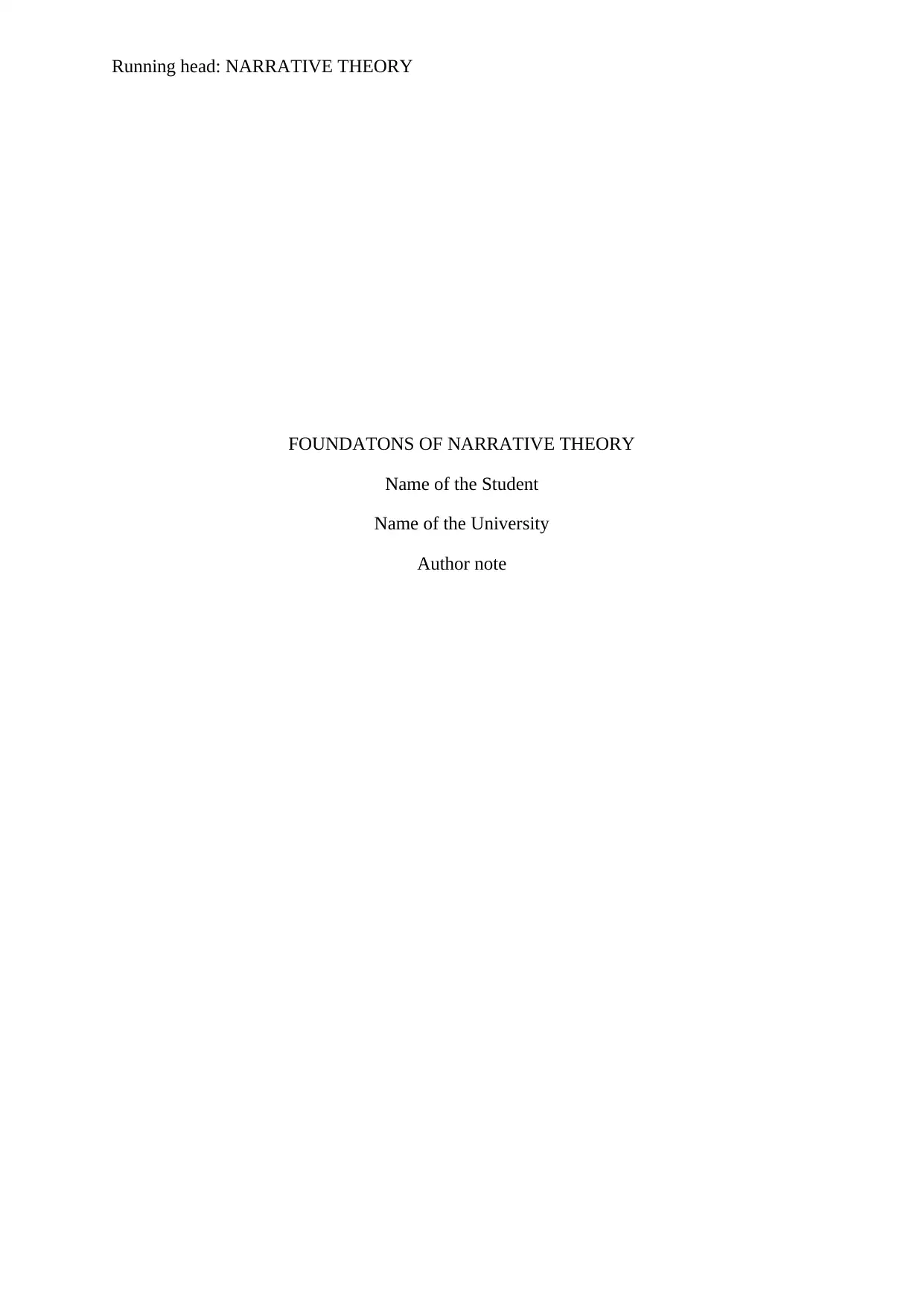
Running head: NARRATIVE THEORY
FOUNDATONS OF NARRATIVE THEORY
Name of the Student
Name of the University
Author note
FOUNDATONS OF NARRATIVE THEORY
Name of the Student
Name of the University
Author note
Paraphrase This Document
Need a fresh take? Get an instant paraphrase of this document with our AI Paraphraser
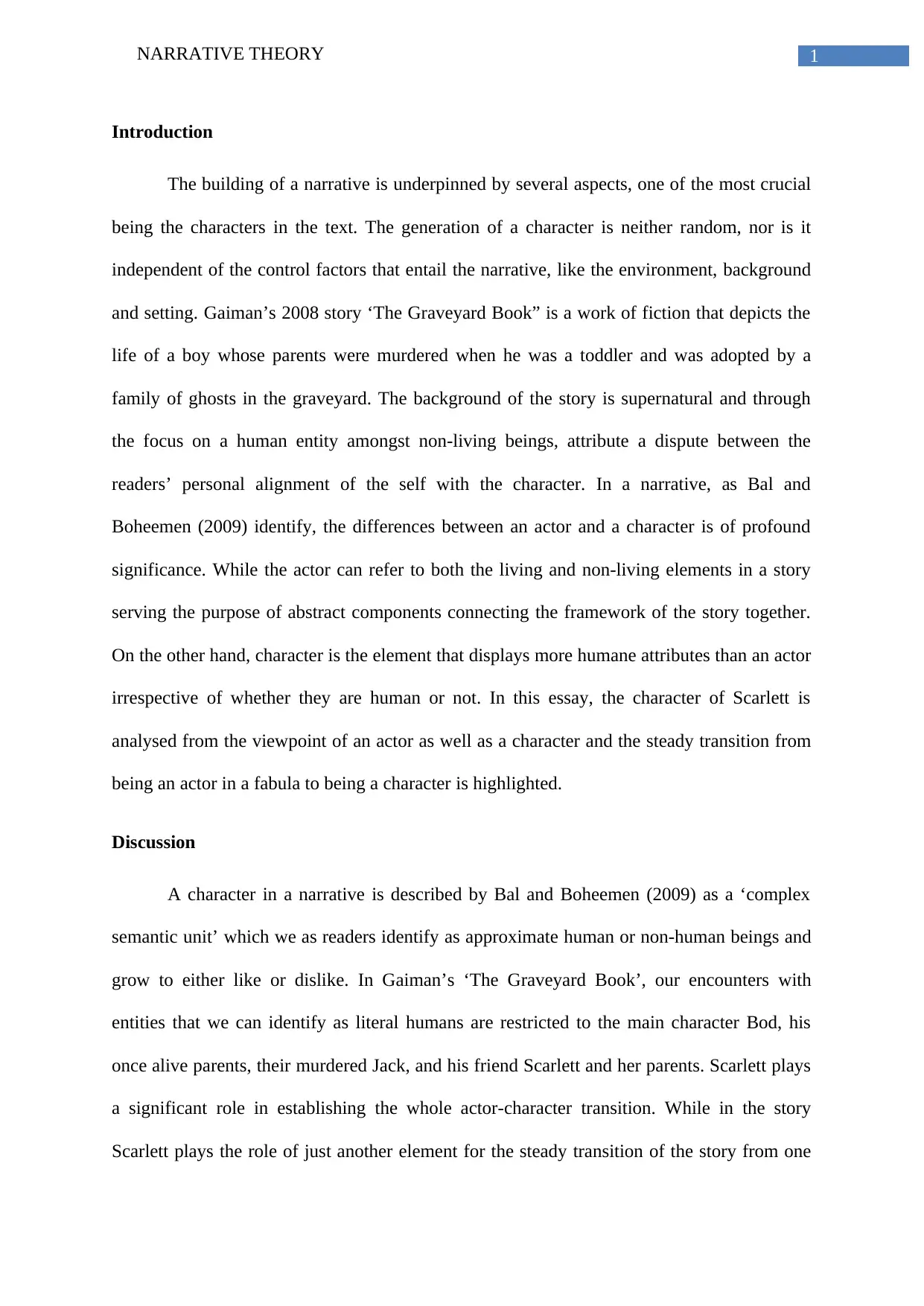
1NARRATIVE THEORY
Introduction
The building of a narrative is underpinned by several aspects, one of the most crucial
being the characters in the text. The generation of a character is neither random, nor is it
independent of the control factors that entail the narrative, like the environment, background
and setting. Gaiman’s 2008 story ‘The Graveyard Book” is a work of fiction that depicts the
life of a boy whose parents were murdered when he was a toddler and was adopted by a
family of ghosts in the graveyard. The background of the story is supernatural and through
the focus on a human entity amongst non-living beings, attribute a dispute between the
readers’ personal alignment of the self with the character. In a narrative, as Bal and
Boheemen (2009) identify, the differences between an actor and a character is of profound
significance. While the actor can refer to both the living and non-living elements in a story
serving the purpose of abstract components connecting the framework of the story together.
On the other hand, character is the element that displays more humane attributes than an actor
irrespective of whether they are human or not. In this essay, the character of Scarlett is
analysed from the viewpoint of an actor as well as a character and the steady transition from
being an actor in a fabula to being a character is highlighted.
Discussion
A character in a narrative is described by Bal and Boheemen (2009) as a ‘complex
semantic unit’ which we as readers identify as approximate human or non-human beings and
grow to either like or dislike. In Gaiman’s ‘The Graveyard Book’, our encounters with
entities that we can identify as literal humans are restricted to the main character Bod, his
once alive parents, their murdered Jack, and his friend Scarlett and her parents. Scarlett plays
a significant role in establishing the whole actor-character transition. While in the story
Scarlett plays the role of just another element for the steady transition of the story from one
Introduction
The building of a narrative is underpinned by several aspects, one of the most crucial
being the characters in the text. The generation of a character is neither random, nor is it
independent of the control factors that entail the narrative, like the environment, background
and setting. Gaiman’s 2008 story ‘The Graveyard Book” is a work of fiction that depicts the
life of a boy whose parents were murdered when he was a toddler and was adopted by a
family of ghosts in the graveyard. The background of the story is supernatural and through
the focus on a human entity amongst non-living beings, attribute a dispute between the
readers’ personal alignment of the self with the character. In a narrative, as Bal and
Boheemen (2009) identify, the differences between an actor and a character is of profound
significance. While the actor can refer to both the living and non-living elements in a story
serving the purpose of abstract components connecting the framework of the story together.
On the other hand, character is the element that displays more humane attributes than an actor
irrespective of whether they are human or not. In this essay, the character of Scarlett is
analysed from the viewpoint of an actor as well as a character and the steady transition from
being an actor in a fabula to being a character is highlighted.
Discussion
A character in a narrative is described by Bal and Boheemen (2009) as a ‘complex
semantic unit’ which we as readers identify as approximate human or non-human beings and
grow to either like or dislike. In Gaiman’s ‘The Graveyard Book’, our encounters with
entities that we can identify as literal humans are restricted to the main character Bod, his
once alive parents, their murdered Jack, and his friend Scarlett and her parents. Scarlett plays
a significant role in establishing the whole actor-character transition. While in the story
Scarlett plays the role of just another element for the steady transition of the story from one
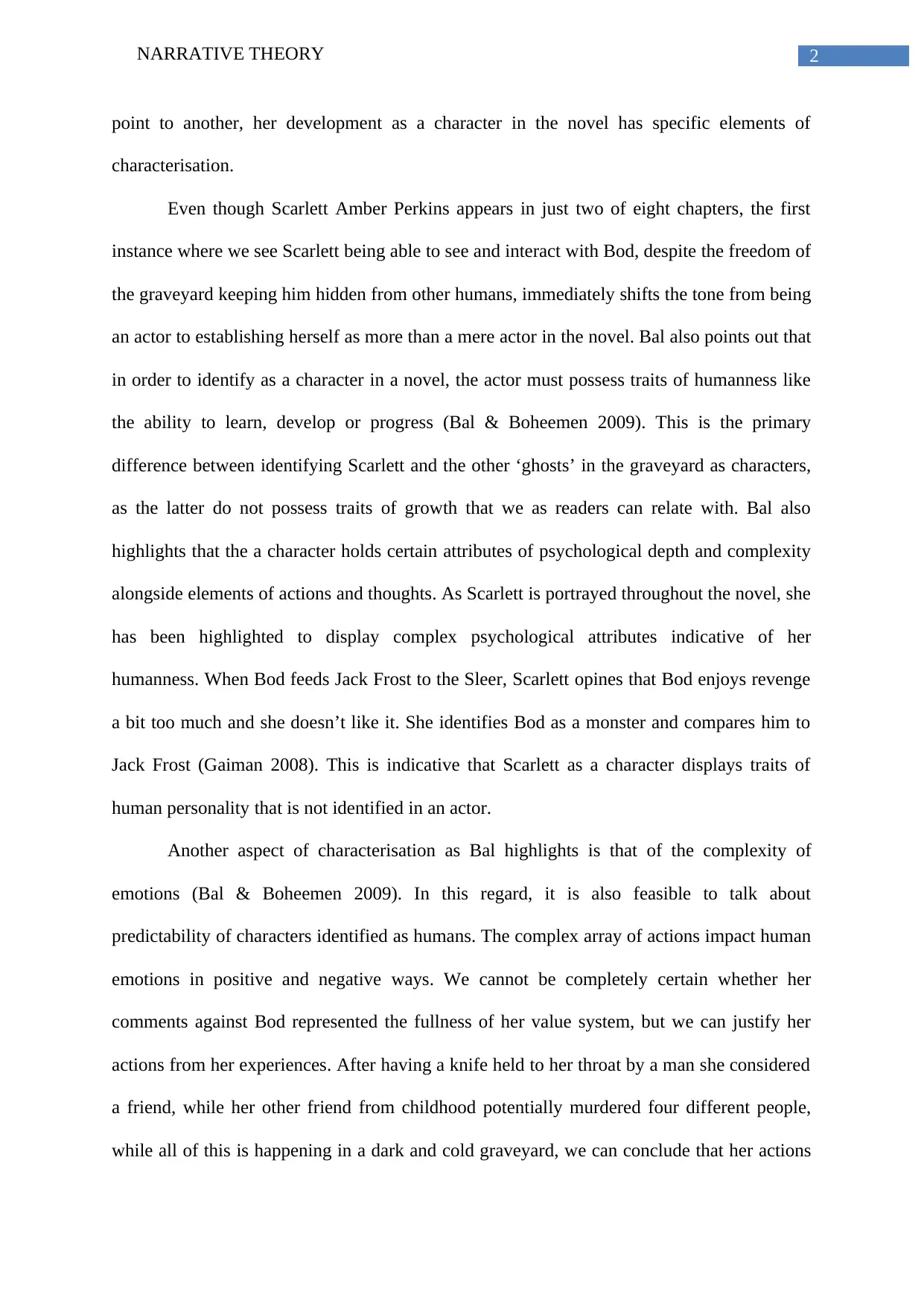
2NARRATIVE THEORY
point to another, her development as a character in the novel has specific elements of
characterisation.
Even though Scarlett Amber Perkins appears in just two of eight chapters, the first
instance where we see Scarlett being able to see and interact with Bod, despite the freedom of
the graveyard keeping him hidden from other humans, immediately shifts the tone from being
an actor to establishing herself as more than a mere actor in the novel. Bal also points out that
in order to identify as a character in a novel, the actor must possess traits of humanness like
the ability to learn, develop or progress (Bal & Boheemen 2009). This is the primary
difference between identifying Scarlett and the other ‘ghosts’ in the graveyard as characters,
as the latter do not possess traits of growth that we as readers can relate with. Bal also
highlights that the a character holds certain attributes of psychological depth and complexity
alongside elements of actions and thoughts. As Scarlett is portrayed throughout the novel, she
has been highlighted to display complex psychological attributes indicative of her
humanness. When Bod feeds Jack Frost to the Sleer, Scarlett opines that Bod enjoys revenge
a bit too much and she doesn’t like it. She identifies Bod as a monster and compares him to
Jack Frost (Gaiman 2008). This is indicative that Scarlett as a character displays traits of
human personality that is not identified in an actor.
Another aspect of characterisation as Bal highlights is that of the complexity of
emotions (Bal & Boheemen 2009). In this regard, it is also feasible to talk about
predictability of characters identified as humans. The complex array of actions impact human
emotions in positive and negative ways. We cannot be completely certain whether her
comments against Bod represented the fullness of her value system, but we can justify her
actions from her experiences. After having a knife held to her throat by a man she considered
a friend, while her other friend from childhood potentially murdered four different people,
while all of this is happening in a dark and cold graveyard, we can conclude that her actions
point to another, her development as a character in the novel has specific elements of
characterisation.
Even though Scarlett Amber Perkins appears in just two of eight chapters, the first
instance where we see Scarlett being able to see and interact with Bod, despite the freedom of
the graveyard keeping him hidden from other humans, immediately shifts the tone from being
an actor to establishing herself as more than a mere actor in the novel. Bal also points out that
in order to identify as a character in a novel, the actor must possess traits of humanness like
the ability to learn, develop or progress (Bal & Boheemen 2009). This is the primary
difference between identifying Scarlett and the other ‘ghosts’ in the graveyard as characters,
as the latter do not possess traits of growth that we as readers can relate with. Bal also
highlights that the a character holds certain attributes of psychological depth and complexity
alongside elements of actions and thoughts. As Scarlett is portrayed throughout the novel, she
has been highlighted to display complex psychological attributes indicative of her
humanness. When Bod feeds Jack Frost to the Sleer, Scarlett opines that Bod enjoys revenge
a bit too much and she doesn’t like it. She identifies Bod as a monster and compares him to
Jack Frost (Gaiman 2008). This is indicative that Scarlett as a character displays traits of
human personality that is not identified in an actor.
Another aspect of characterisation as Bal highlights is that of the complexity of
emotions (Bal & Boheemen 2009). In this regard, it is also feasible to talk about
predictability of characters identified as humans. The complex array of actions impact human
emotions in positive and negative ways. We cannot be completely certain whether her
comments against Bod represented the fullness of her value system, but we can justify her
actions from her experiences. After having a knife held to her throat by a man she considered
a friend, while her other friend from childhood potentially murdered four different people,
while all of this is happening in a dark and cold graveyard, we can conclude that her actions
⊘ This is a preview!⊘
Do you want full access?
Subscribe today to unlock all pages.

Trusted by 1+ million students worldwide
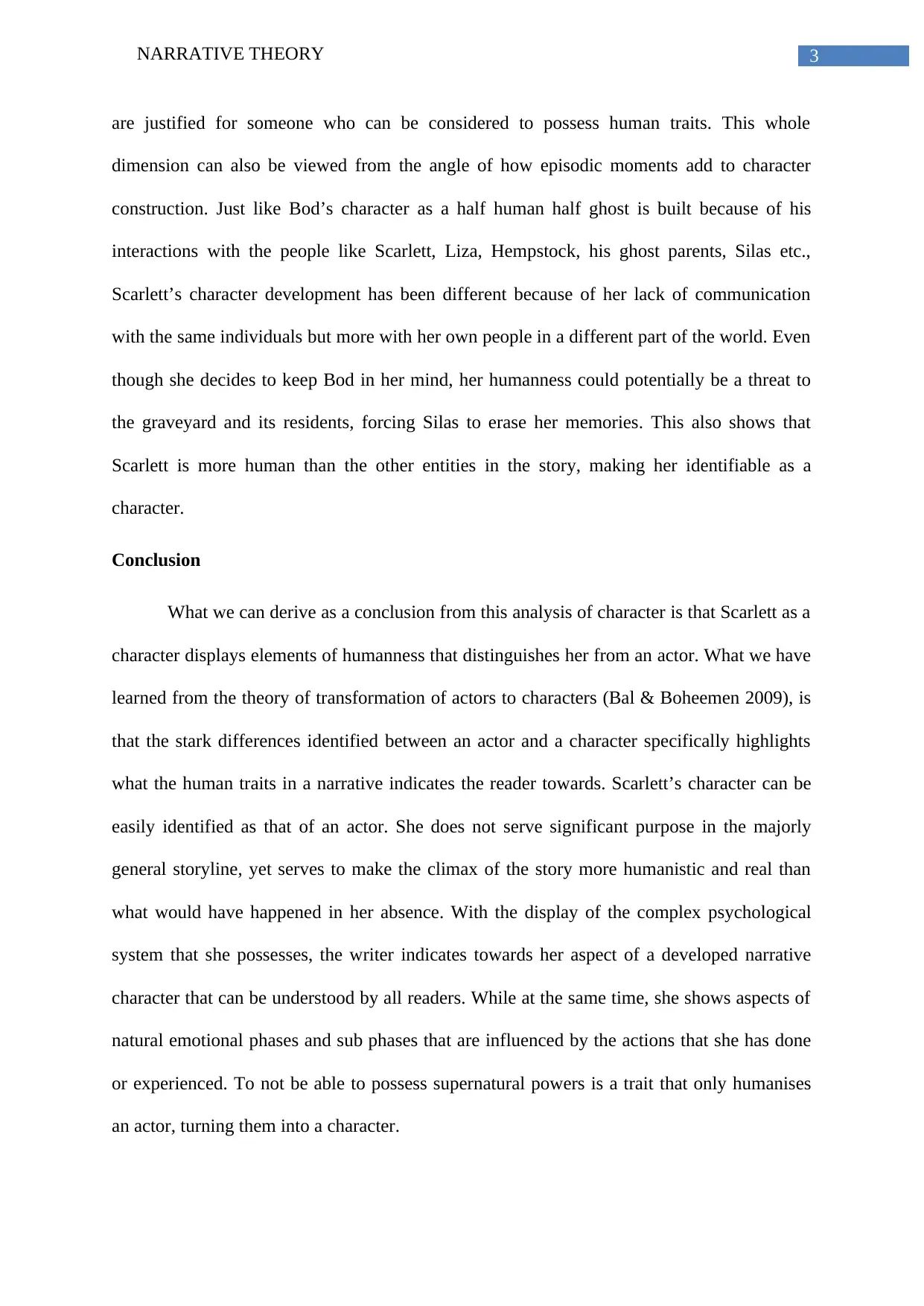
3NARRATIVE THEORY
are justified for someone who can be considered to possess human traits. This whole
dimension can also be viewed from the angle of how episodic moments add to character
construction. Just like Bod’s character as a half human half ghost is built because of his
interactions with the people like Scarlett, Liza, Hempstock, his ghost parents, Silas etc.,
Scarlett’s character development has been different because of her lack of communication
with the same individuals but more with her own people in a different part of the world. Even
though she decides to keep Bod in her mind, her humanness could potentially be a threat to
the graveyard and its residents, forcing Silas to erase her memories. This also shows that
Scarlett is more human than the other entities in the story, making her identifiable as a
character.
Conclusion
What we can derive as a conclusion from this analysis of character is that Scarlett as a
character displays elements of humanness that distinguishes her from an actor. What we have
learned from the theory of transformation of actors to characters (Bal & Boheemen 2009), is
that the stark differences identified between an actor and a character specifically highlights
what the human traits in a narrative indicates the reader towards. Scarlett’s character can be
easily identified as that of an actor. She does not serve significant purpose in the majorly
general storyline, yet serves to make the climax of the story more humanistic and real than
what would have happened in her absence. With the display of the complex psychological
system that she possesses, the writer indicates towards her aspect of a developed narrative
character that can be understood by all readers. While at the same time, she shows aspects of
natural emotional phases and sub phases that are influenced by the actions that she has done
or experienced. To not be able to possess supernatural powers is a trait that only humanises
an actor, turning them into a character.
are justified for someone who can be considered to possess human traits. This whole
dimension can also be viewed from the angle of how episodic moments add to character
construction. Just like Bod’s character as a half human half ghost is built because of his
interactions with the people like Scarlett, Liza, Hempstock, his ghost parents, Silas etc.,
Scarlett’s character development has been different because of her lack of communication
with the same individuals but more with her own people in a different part of the world. Even
though she decides to keep Bod in her mind, her humanness could potentially be a threat to
the graveyard and its residents, forcing Silas to erase her memories. This also shows that
Scarlett is more human than the other entities in the story, making her identifiable as a
character.
Conclusion
What we can derive as a conclusion from this analysis of character is that Scarlett as a
character displays elements of humanness that distinguishes her from an actor. What we have
learned from the theory of transformation of actors to characters (Bal & Boheemen 2009), is
that the stark differences identified between an actor and a character specifically highlights
what the human traits in a narrative indicates the reader towards. Scarlett’s character can be
easily identified as that of an actor. She does not serve significant purpose in the majorly
general storyline, yet serves to make the climax of the story more humanistic and real than
what would have happened in her absence. With the display of the complex psychological
system that she possesses, the writer indicates towards her aspect of a developed narrative
character that can be understood by all readers. While at the same time, she shows aspects of
natural emotional phases and sub phases that are influenced by the actions that she has done
or experienced. To not be able to possess supernatural powers is a trait that only humanises
an actor, turning them into a character.
Paraphrase This Document
Need a fresh take? Get an instant paraphrase of this document with our AI Paraphraser
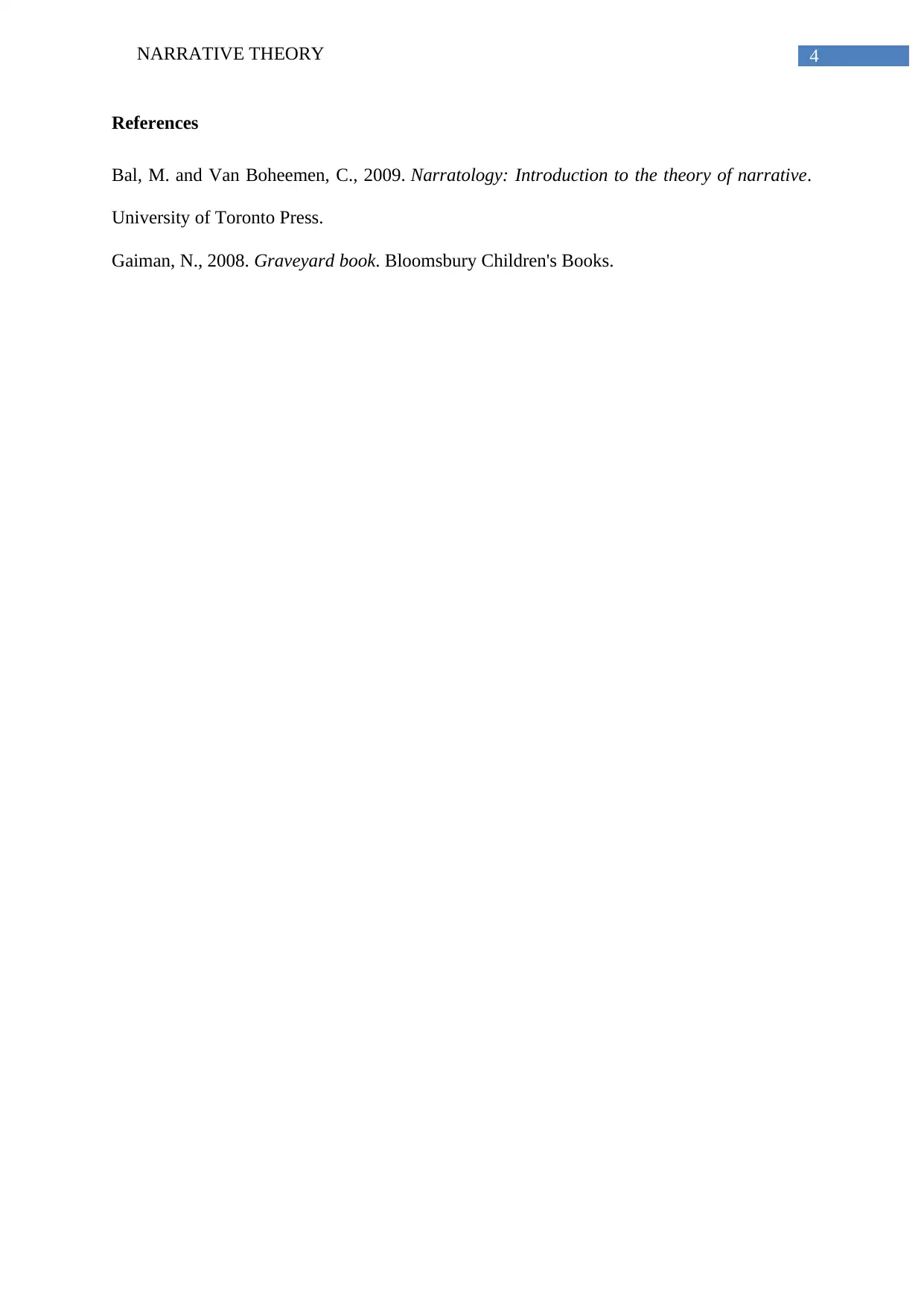
4NARRATIVE THEORY
References
Bal, M. and Van Boheemen, C., 2009. Narratology: Introduction to the theory of narrative.
University of Toronto Press.
Gaiman, N., 2008. Graveyard book. Bloomsbury Children's Books.
References
Bal, M. and Van Boheemen, C., 2009. Narratology: Introduction to the theory of narrative.
University of Toronto Press.
Gaiman, N., 2008. Graveyard book. Bloomsbury Children's Books.
1 out of 5
Your All-in-One AI-Powered Toolkit for Academic Success.
+13062052269
info@desklib.com
Available 24*7 on WhatsApp / Email
![[object Object]](/_next/static/media/star-bottom.7253800d.svg)
Unlock your academic potential
Copyright © 2020–2025 A2Z Services. All Rights Reserved. Developed and managed by ZUCOL.